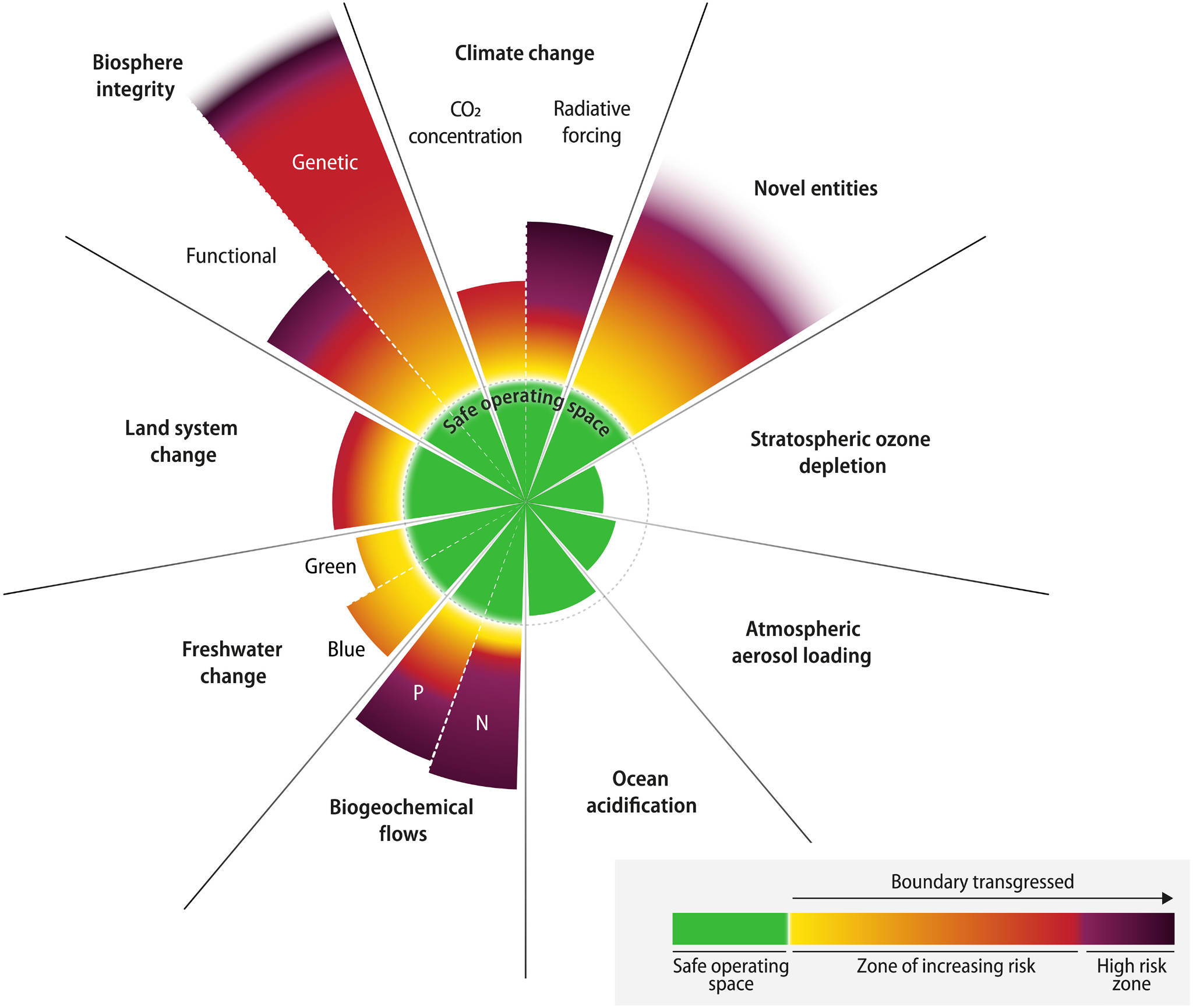Planetary boundaries
What are Planetary boundaries ?
- Developed in 2009, planetary boundaries refers to a set of nine environmental boundaries or limits that define the safe operating space for humanity within the Earth’s ecosystems.
- These boundaries are meant to represent the biophysical thresholds that, if crossed, could lead to abrupt and irreversible environmental changes, posing risks to human well-being and the stability of the planet.
Nine Planetary boundaries
- Climate Change: The concentration of carbon dioxide (CO2) in the atmosphere, which contributes to global warming.
- Biosphere Integrity: The overall health and functioning of ecosystems, including biodiversity and the extent of intact habitats.
- Stratospheric Ozone Depletion: The concentration of ozone-depleting substances in the atmosphere, which affects the protective ozone layer in the stratosphere.
- Ocean Acidification: The acidity of the oceans, primarily driven by increased carbon dioxide absorption, which can have detrimental effects on marine life, especially organisms with calcium carbonate shells.
- Biogeochemical Flows (Nitrogen and Phosphorus): The human-driven flow of nitrogen and phosphorus into the environment, which can lead to nutrient imbalances and environmental degradation, such as eutrophication of water bodies.
- Land System Change: Changes in land use, including deforestation, urbanization, and other alterations to natural landscapes.
- Freshwater Use: Human consumption of freshwater resources, with a focus on sustainable water management to avoid depletion and ecosystem degradation.
- Novel entities: Levels of plastic, concrete, synthetic chemicals, gene-modified organisms, etc. that would not be found on Earth if we humans were not here.
- Atmospheric Aerosol Loading: The concentration of particulate matter in the atmosphere, which can affect air quality and have climate-related impacts.

Why in News?
- According to a new study, the world has breached six of the nine planetary boundaries necessary to maintain Earth’s stability and resilience.
- The six boundaries include climate change, biosphere integrity, land system change, freshwater change, biogeochemical flows, and novel entities.
- This is the third iteration of the framework carried out by 29 scientists from eight different countries.
Findings of the study
- The broken boundaries show Earth’s life-support systems have been driven far away from the safe operating space for humanity that existed during the Holocene period.
- One of the most concerning evaluations is the overflow of nitrogen and phosphorus — the biogeochemical flow boundary — in the environment. Although nitrogen and phosphorus are essential for life, their widespread use as crop fertilisers is wreaking havoc by, for instance, triggering algal blooms (it can cause entire fish populations to leave an area or even die) and ocean dead zones (a reduced level of oxygen in the water).
- Another alarming finding is the rising levels of novel entities in the environment such as pesticides and plastic, which are destabilizing and harming the Earth’s system.
- For climate change, the analysis notes that both the atmospheric CO2 concentration and radiative forcing are steadily increasing. For instance, CO2 concentration currently stands at 417 parts per million (ppm), whereas it was just 280 ppm before the Industrial Revolution. Its safe boundary limit is 350 ppm, which was breached in the 1980s.
- For land system change, the global area of forested land as the percentage of the original forest cover boundary has dropped to 60 per cent, which is beyond safe limits.
- Currently, it is estimated around one million of the 8 million plant and animal species are threatened with extinction, and over 10 per cent of the genetic diversity of plants and animals may have been wiped out over the last 150 years.
Other 3 Planetary boundaries
- While atmospheric aerosol loading and ozone depletion remain within the constraints, ocean acidification is close to being breached.
- Notably, the one improving boundary, the stratospheric ozone depletion boundary, is recovering owing to the combined international efforts initiated by the Montreal Protocol in 1987. Researchers say this level of coordinated change may help in dealing with other boundaries.
Subscribe
Login
0 Comments
